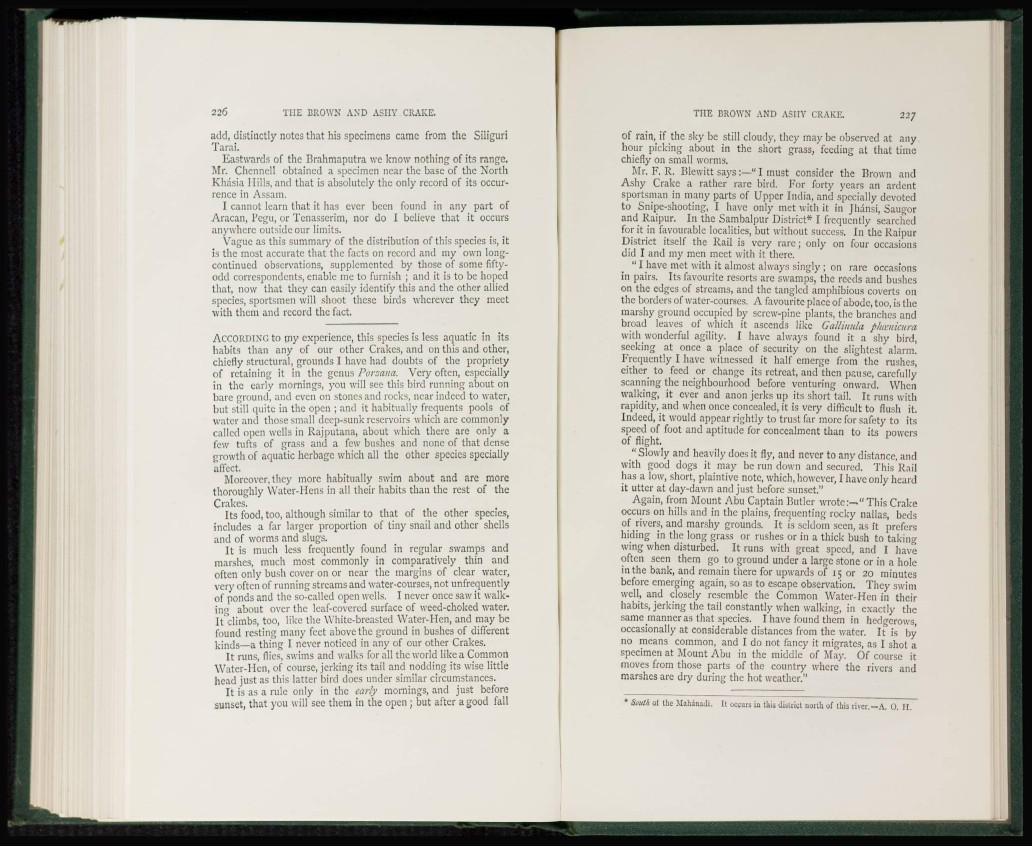
add, distinctly notes that his specimens came from the Siliguri
Tarai.
Eastwards of the Brahmaputra we know nothing of its range.
Mr. Chenncll obtained a specimen near the base of the North
Khasia Hills, and that is absolutely the only record of its occurrence
in Assam.
I cannot learn that it has ever been found in any part of
Aracan, Pegu, or Tenasscrim, nor do I believe that it occurs
anywhere outside our limits.
Vague as this summary of the distribution of this species is, it
is the most accurate that the facts on record and my own longcontinued
observations, supplemented by those of some fiftyodd
correspondents, enable me to furnish ; and it is to be hoped
that, now that they can easily identify this and the other allied
species, sportsmen will shoot these birds wherever they meet
with them and record the fact.
ACCORDING to my experience, this species is less aquatic in its
habits than any of our other Crakes, and on this and other,
chiefly structural, grounds I have had doubts of the propriety
of retaining it in the genus Porzana. Very often, especially
in the early mornings, you will see this bird running about on
bare ground, and even on stones and rocks, near indeed to water,
but still qttitc in the open ; and it habitually frequents pools of
Water and those small deep-sunk reservoirs which arc commonly
called open wells in Rajputana, about which there are only a
few tufts of grass and a few bushes and none of that dense
growth of aquatic herbage which all the other species specially
affect.
Moreover, they more habitually swim about and are more
thoroughly Watcr-Hcns in all their habits than the rest of the
Crakes.
Its food, too, although similar to that of the other species,
includes a far larger proportion of tiny snail and other shells
and of worms and slugs.
It is much less frequently found in regular swamps and
marshes, much most commonly in comparatively thin and
often only bush cover on or near the margins of clear water,
very often of running streams and water-courses, not unfrequently
of ponds and the so-called open wells. I never once saw it walking
about over the leaf-covered surface of weed-choked water.
It climbs, too, like the White-breasted Water-Hen, and may be
found resting many feet above the ground in bushes of different
kinds—a thing I never noticed in any of our other Crakes.
It runs, flics, swims and walks for all the world like a Common
Water-Hen, of course, jerking its tail and nodding its wise little
head just as this latter bird does under similar circumstances.
It is as a rule only in the early mornings, and just before
sunset, that you will see them in the open ; but after a good fall
of rain, if the sky be still cloudy, they may be observed at any
hour picking about in the short grass, feeding at that time
chiefly on small worms.
Mr. F. R. Blcwitt says:—" I must consider the Brown and
Ashy Crake a rather rare bird. For forty years an ardent
sportsman in many parts of Upper India, and specially devoted
to Snipe-shooting, I have only met with it in Jhansi, Saugor
and Raipur. In the Sambalpur District* I frequently searched
for it in favourable localities, but without success. In the Raipur
District itself the Rail is very rare; only on four occasions
did I and my men meet with it there.
" I have met with it almost always singly ; on rare occasions
in pairs. Its favourite resorts arc swamps, the reeds and bushes
on the edges of streams, and the tangled amphibious coverts on
the borders of water-courses. A favourite place of abode, too, is the
marshy ground occupied by screw-pine plants, the branches and
broad leaves of which it ascends like Gallinula plaenicura
with wonderful agility. I have always found it a shy bird,
seeking at once a place of security on the slightest alarm.
Frequently I have witnessed it half emerge from the rushes,
either to feed or change its retreat, and then pause, carefully
scanning the neighbourhood before venturing onward. When
walking, it ever and anon jerks up its short tail. It runs with
rapidity, and when once concealed, it is very difficult to flush it.
Indeed, it would appear rightly to trust far more for safety to its
speed of foot and aptitude for concealment than to its powers
of flight.
" Slowly and heavily docs it fly, and never to any distance, and
with good dogs it may be run down and secured. This Rail
has a low, short, plaintive note, which, however, I have only heard
it utter at day-dawn and just before sunset."
Again, from Mount Abu Captain Butler wrote:—"This Crake
occurs on hills and in the plains, frequenting rocky nallas, beds
of rivers, and marshy grounds. It is seldom seen, as it prefers
hiding in the long grass or rushes or in a thick bush to taking
wing when disturbed. It runs with great speed, and I have
often seen them go to ground under a large stone or in a hole
in the bank, and remain there for upwards of 15 or 20 minutes
before emerging again, so as to escape observation. They swim
well, and closely resemble the Common Water-Hen in their
habits, jerking the tail constantly when walking, in exactly the
same manner as that species. I have found them in hedgerows,
occasionally at considerable distances from the water. It is by
no means common, and I do not fancy it migrates, as I shot a
specimen at Mount Abu in the middle of May. Of course it
moves from those parts of the country where the rivers and
marshes are dry during the hot weather."
* South of the Mahanadi. It occurs in this district north of this river.—A. O. H.